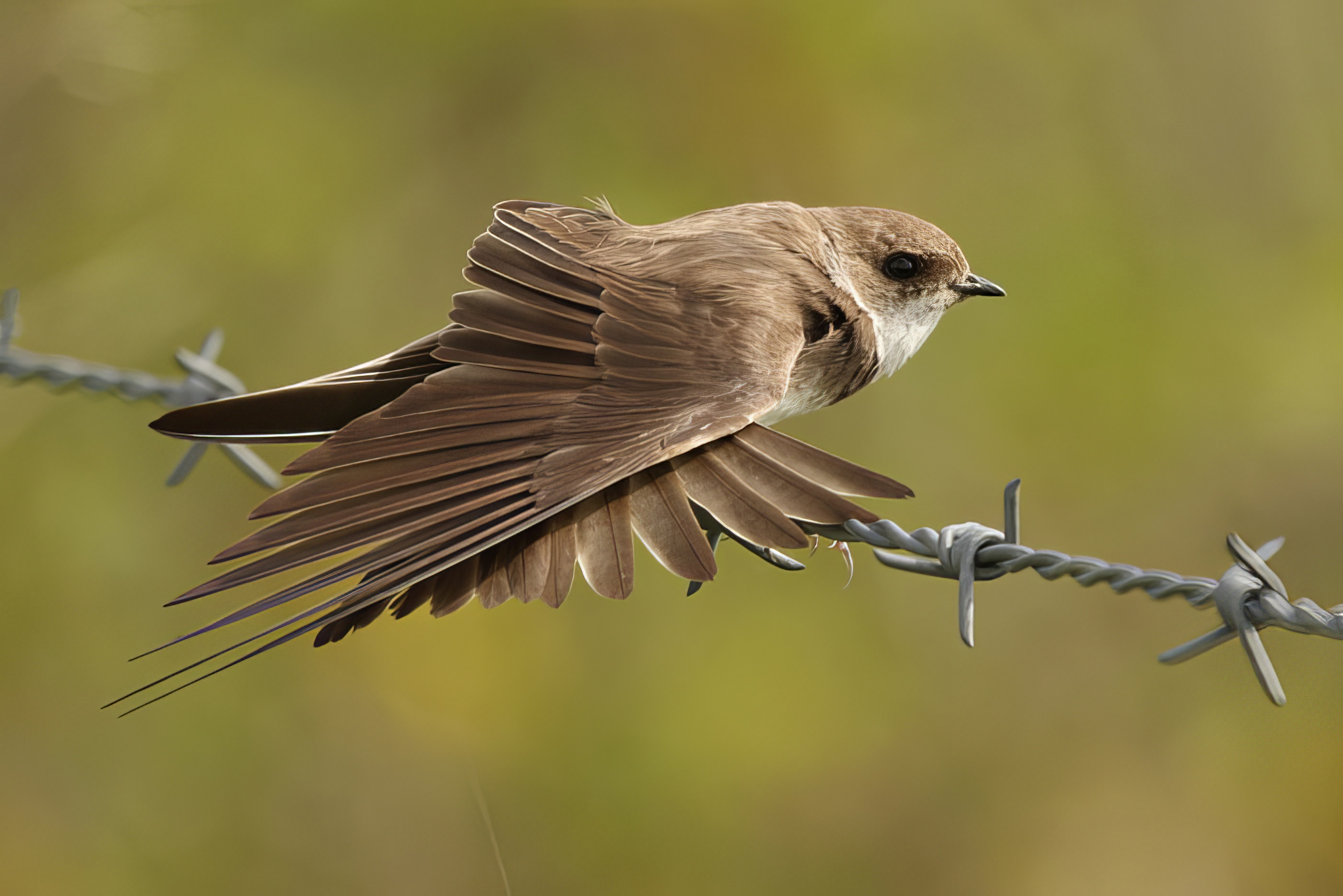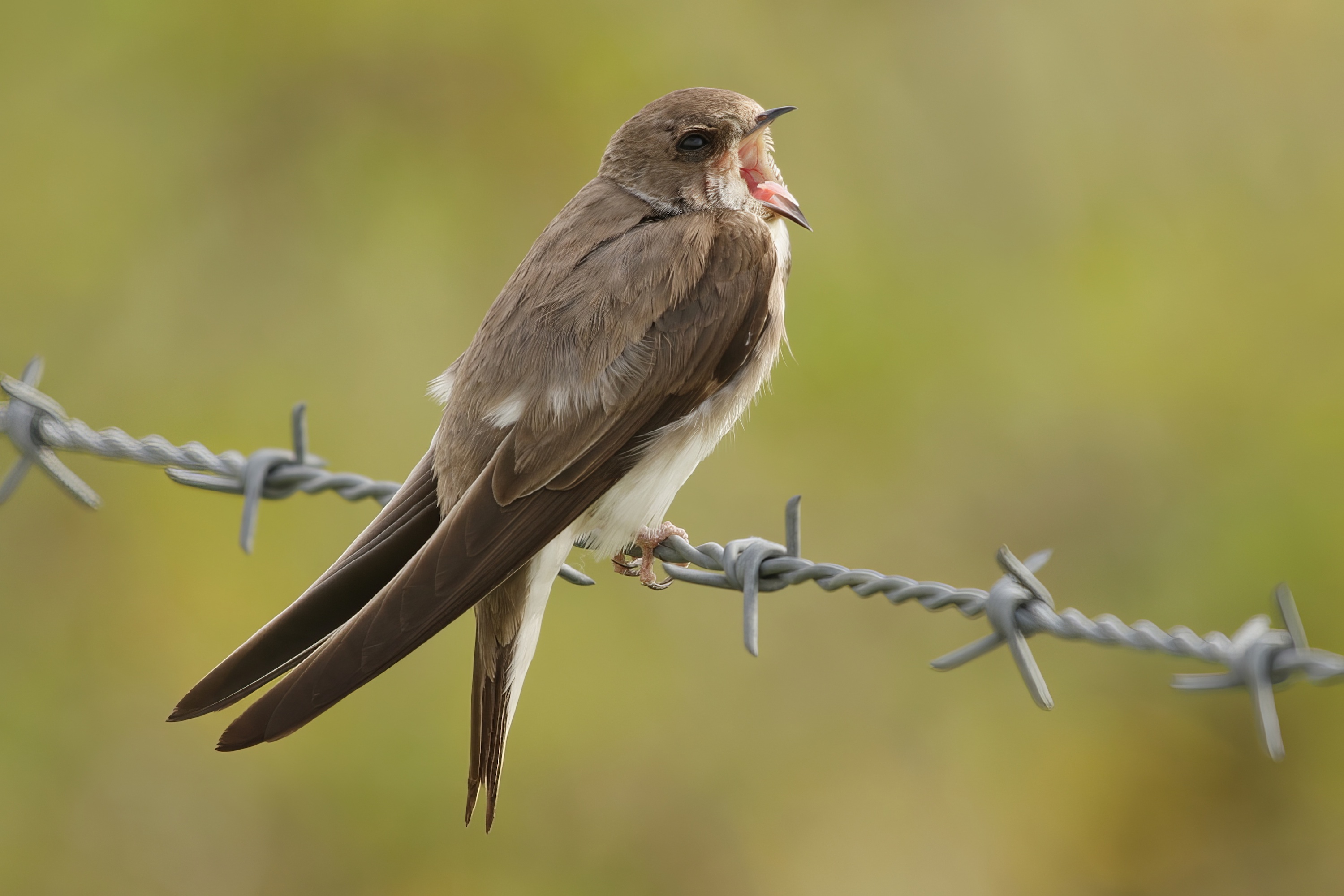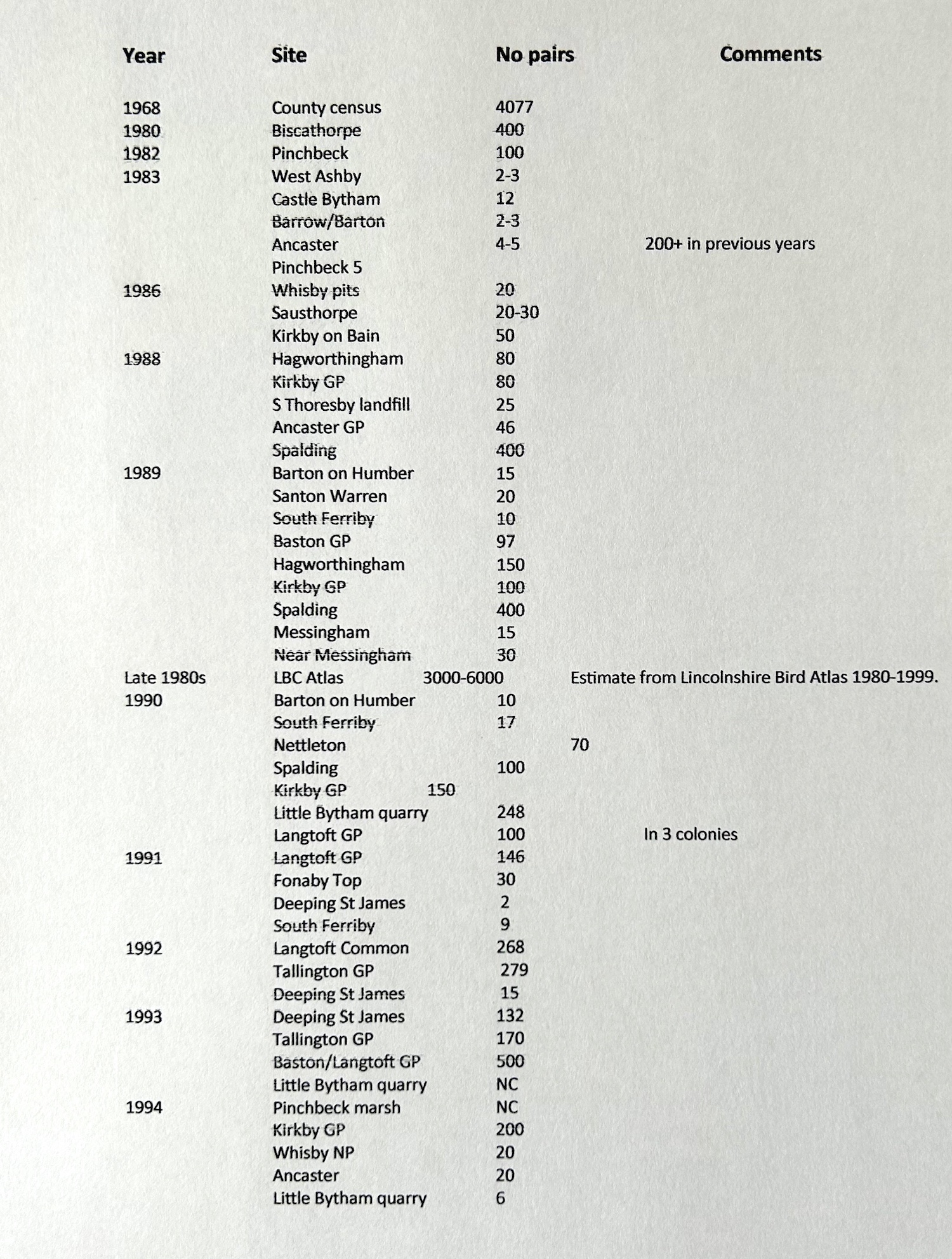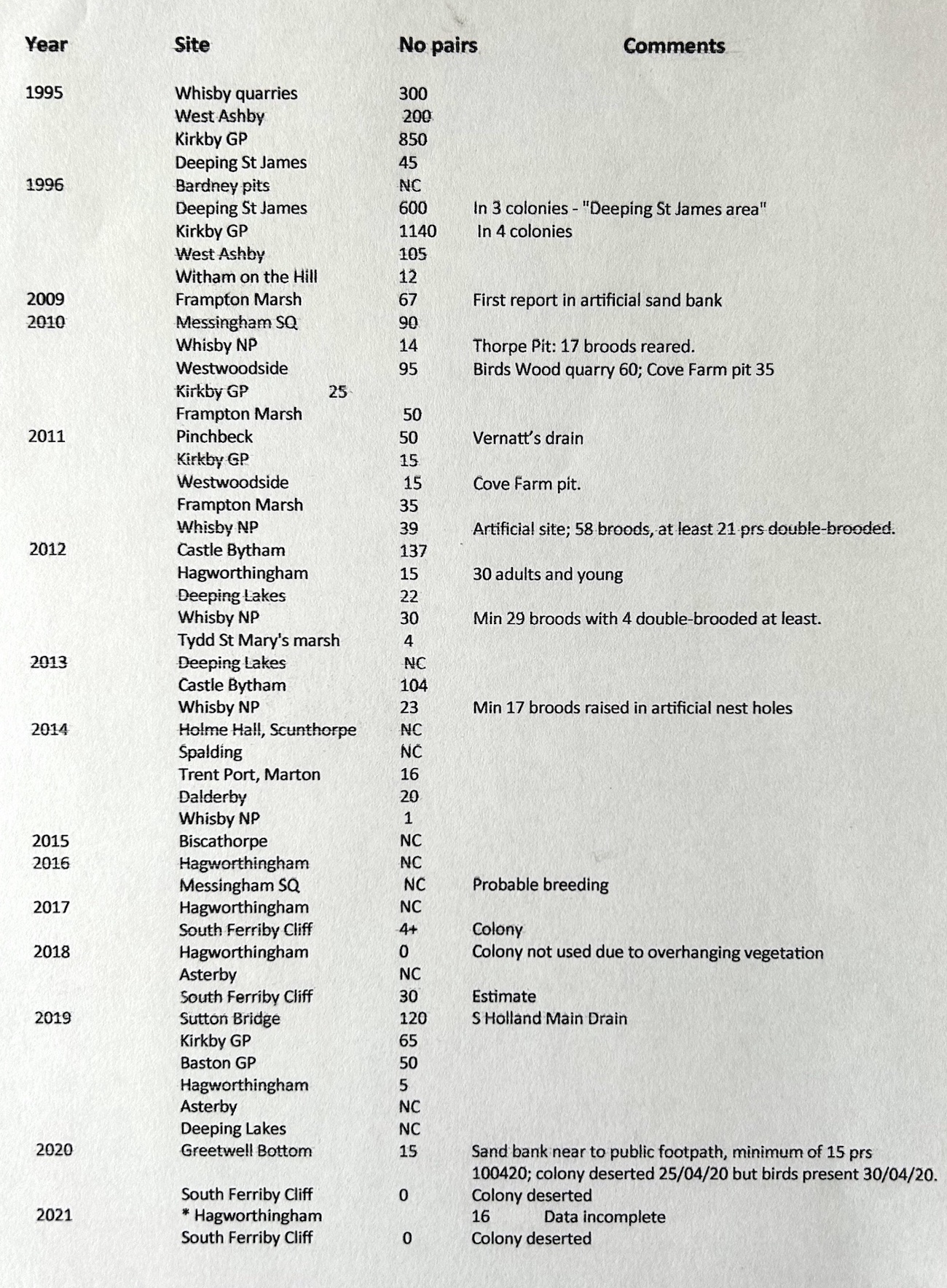Sand Martin Riparia riparia
Common but declining summer visitor and passage migrant.


The Atlas estimated around 3,000-6,000 pairs of this tunnelling Martin in the late 1980s and it provides a good account of the woes this species had suffered in the previous 20 years. Its distribution is limited by the availability of suitable nest sites for which it requires near vertical sandy cliffs. Many breeding sites in sand and gravel quarries have been lost due to concerns about the health and safety of the remaining excavations. The BTO Atlas has reflected a steady loss in distribution from 1968-72 in the county with net losses in 1988-91 from ten 10km squares and further net loss from 7 squares in 2007-11. The APEP4 adjusted population for Lincs in 2016 was 3000 pairs. Very little information on breeding colonies gets reported in LBR. Sand Martin is generally one of our earliest migrants arriving in early March. It usually leaves earlier too, most birds having passed through by early September. Natural sites are scarce these days and limited to riverbanks and occasional soft sandstone outcrops. Providing artificial banks has met with mixed success. Frampton Marsh had a good initial take up, but then predatory Mustelids caused mass desertion. A more recent construction at Bescathorpe has had better success:
| Year | Adults | Nestlings |
| 2015 | 0 | 6 |
| 2016 | 0 | 25 |
| 2017 | 11 | 129 |
| 2018 | 0 | 0 |
| 2019 | 16 | 168 |
| 2020 | Unknown | 268 |
| 2021 | 43 | 358 |
Adult and nestling Sand Martins ringed 2015-2021 at the artificial nest site
at Biscathorpe (data courtesy of the Mid-Lincs Ringing Group).
However, the Biscathorpe colony suffered the same fate as that at Frampton Marsh when in 2017 all of the second broods were predated, probably by the same agents - mustelids. The result was that the entire colony deserted and in the following year, 2018, no birds returned. Since then the colony has returned though, and with resounding success with 794 nestlings ringed 2019-2021. Furthermore, the first foreign recovery was reported in August 2021 when a nestling ringed on 21st was retrapped on 26th at Saint-Vigor-d'Ymonville on the Seine estuary, 437km to the south. More details of this colony and a record of Sand Martin colonies in the county were documented by Britton (2020); a tremendous and ongoing project by the MId-Lincs Ringing Group. Hundreds of Sand Martins have been ringed in Lincolnshire and these have yielded recoveries in Algeria, Belgium, Cape Verde and Channel Islands, France, and Senegal. Conversely, foreign-ringed Sand Martins trapped in Lincolnshire have come from Belgium, the Channel Islands, Hungary, Morocco, Netherlands and Senegal.
Artificial Sand Martin nest site at Biscathorpe
by Stuart Britton - Mid-Lincs Ringing Group
Background
Since the late 1970’s the Mid-Lincs Ringing Group (MLRG) has been ringing Sand Martins at a Sand Quarry owned by the Wallis family at Biscathorpe. In the early 1980’s an exploratory oil drilling rig was set up beside the working face and had no detrimental effect on the birds. When the Quarry was worked out, the face was unsuitable for nesting as it had weeded over so ringers Andy Chappelland Ian Kingswood tried to scrape the banks to make them attractive to Sand Martins, but this was unsuccessful. Kevin Wallis was eager to get Sand Martins breeding again so he asked Andy if the Group could build an artificial site.
Construction of the nest site
Andy did some research and found plans on the BTO Website. Kevin agreed to assist in providing building materials with Andy and MLRG members being responsible for the construction. It was decided to construct two tiers of nest holes totalling 36 which were in a breeze block building constructed beside the quarry. The nest holes were made from drainage pipes and lead to a smallnest chamber that can be accessed from a narrow corridor in the building. Each chamber has a numbered wooden, hinged hatch which gives Andy the ability to check and record the contents of each nest. The building was finished in 2014 and each hole was partially filled with sand.
Occupancy and breeding success
In July 2015 one of the nest chambers was occupied and six nestlings were ringed. The following year, 2016, five were occupied and 25 nestlings ringed. There was a much bigger uptake the following year when 129 nestlings and 11 adults were ringed – this was done by setting up a mist net in front of the holes at first light. Andy went to check for second broods and found that all the nests had been predated, probably by a Stoat or Weasel. This had a devastating effect on the colony, and it was immediately deserted. Despite some modifications to prevent a reoccurrence no Sand Martins returned in 2018. However, in 2019 Andy was delighted to find a lot of occupied nests and by the end of the season 168 nestlings and 16 adults had been ringed. In 2020, we saw the most productive year so far, and 268 nestlings were ringed – the first on May 31st and the last on August 26th. To date only one of the ringed nestlings has been found elsewhere - at an artificial site at Rutland Water. All the data has been submitted to the BTO Nest Record Scheme. As far as we are aware this is the only artificial site in the county which has provided easy access to the nest chambers. It provides valuable information on clutch and brood size and the exact age of the birds. The MLRG would like to acknowledge the continued support of the Wallis family and particularly Kevin on this project. Please note the site is private and there is no public access without the owner’s permission. Finally, Andy Chappell’s skill and dedication has made this long-term project possible.
Update, 2021
Last 8 pulli ringed on Aug 30th. It has been the best year for the Sand Martin bank - 163 were ringed in 2019, 267 in 2020 and 358 in 2021; six more fledged in 2021 before they could be ringed. So, in 2021 there were 79 nests in total with 36 first broods (188 nestlings ringed), 32 second broods and 11 third broods. These averaged 4.53 pulli per nest. MLRG also ringed 43 adults in 2021 and retrapped 14, all but 1 of them from 2019. One bird was controlled from Rutland water. One of the 2021 young was retrapped at Lands’ End less than 30 days after it was ringed as a pullus. The MLRG had their first foreign recovery of a nestling ringed at the Biscathorpe colony: this bird was ringed on August 1st, 2021, and trapped alive on Aug 26th, 2021, at Saint-Vigor-d’Ymonville on the north side of the Seine estuary, France, 437km to the south.
Sand Martin colonies elsewhere in the county
The data which we have on record is summarised in the following table and is incomplete for several reasons. These include a lack of systematic checks on colonies; ephemeral colonies nesting opportunistically for one or two seasons only at temporary sites; no complete annual reports, 1997-2008. The Lincolnshire Bird Atlas 1980-199: an historical perspective stated that confirmed breeding occurred in 65 x 1km squares; probable breeding in 22 x 1km squares; possible breeding in 19 x 1km squares. In the 1960s there were many very large colonies in active sand and gravel workings in the Wolds and all the main river valleys where the nest holes are usually excavated in vertical sandy cliffs - a countywide census in 1968 identified 4077 occupied nest holes). Unusual and opportunistic nest sites may also be utilised, such as that at Hall Weir, Kirton in 1990 when a small colony of 14 nests was discovered by Garry Steele in the exposed root plate of a huge Crack Willow felled by autumn gales; this short-lived site also supported an active Kingfisher nest. Another colony monitored by Garry is at Hagworthingham in a sandy cliff next to what is now a small commercial area. It has been in existence for at least 45 years to his knowledge and he periodically clears away overhanging vegetation allowing access to the nest holes.
Droughts in the Sahel region in 1968-69 and 1983-4 caused significant population crashes and the species became much less widespread thereafter. The 1984 county report noted that there had been a huge countywide decline, although few colony counts were reported that year. By 1989, some larger colonies of 100-400 holes began to appear again and The Atlas estimated that in occupied 1km squares that 50-100 pairs were likely to be present and further estimated that this could translate to a county total of 3,000-6,000 pairs. Since the 1968 census, the sites that LBC has on record as having confirmed or probable breeding are listed in the table appended to this article, with estimated numbers of occupied nest holes given when recorded.
Table: Sand Martin colony nest counts, 1968-2021, from published Lincolnshire Bird Reports and other literature sources.


Reference
Britton, S & Mid-Lincs Ringing Group (2020). Artificial Sand Martin nest site at Biscathorpe. Lincolnshire Bird Report 2020: 244-248.
(Account as per new Birds of Lincolnshire (2021), included October 2022; updated July 2023)
